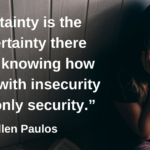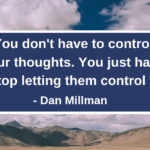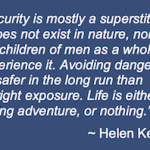Kristen Taylor-Ladd, MA, AMFT, of the OCD Center of Los Angeles, discusses the differences between, and often co-occurring, afflictions of OCD and GAD, as well as shares her personal experience with and way to recovery from both of these conditions.

Both Generalized Anxiety Disorder (GAD) and Obsessive Compulsive Disorder (OCD) can often exist together simultaneously. It is also common for individuals struggling with OCD to be diagnosed with or assume they have Generalized Anxiety Disorder instead, which can be a frequent misdiagnosis. When this misdiagnosis happened to me, I felt unheard. I didn’t understand the obsessive thoughts and compulsions I was experiencing, especially when those symptoms didn’t fit in with my diagnosis of Generalized Anxiety Disorder and what I understood that to be. Learning that both OCD and GAD can occur together can be a powerful and validating tool. While most people with Generalized Anxiety Disorder (GAD) don’t have Obsessive Compulsive Disorder (OCD), it may be common for individuals with OCD to also have GAD.
It took time, treatment in therapy, and a lot of self-reflection to come to terms with the understanding that I struggled with both Generalized Anxiety Disorder and Obsessive Compulsive Disorder. Gaining an understanding of these conditions provided much-needed clarification and validation for my experiences, which helped immensely in my management and overall treatment.
Obsessive Compulsive Disorder (OCD) is listed in the Diagnostic and Statistical Manual of Mental Disorders (DSM-5) and is defined by the presence of obsessions, compulsions, or both.
Obsessions are defined as:
– Recurrent and persistent thoughts, urges, or images that are experienced, at some time, during the disturbance, as intrusive and unwanted, and that in most individuals cause marked anxiety or distress.
– The individual attempts to ignore or suppress such thoughts, urges, or images, or to neutralize them with some other thought or action (by performing a compulsion)
Compulsions are defined as:
– Repetitive behaviors that the person feels driven to perform in response to an obsession, or according to the rules that must be applied rigidly.
– The behaviors or mental acts are aimed at preventing or reducing distress or preventing some dreaded event or situation. However, these behaviors or mental acts either are not connected in a realistic way with what they are designed to neutralize or prevent or are clearly excessive.
– The obsessions or compulsions are time consuming (e.g., take more than 1 hour per day) or cause clinically significant distress or impairment in social, occupational, or other important areas of functioning.
Generalized Anxiety Disorder (GAD) is listed in the DSM-5 and defined as excessive anxiety and worry about a number of events or activities such as work or school, you may find it difficult to control the worry, and is associated with some of the below symptoms:
– Restlessness or feeling keyed up or on edge
– Being easily fatigued
– Difficulty concentrating or mind going blank
– Irritability
– Muscle tension
– Sleep disturbance (difficulty falling asleep or staying asleep, restless, or unsatisfying sleep)
Just don’t be anxious, everything is fine. I heard for probably the hundredth time. I’m sure anyone with anxiety has been told this well-intentioned statement of reassurance from the people around them, only to find it not quite as helpful as the thought behind it. Maybe if I just worried less…cared less…planned more, I wouldn’t feel this way. I internally repeated this type of thinking often, in an attempt to lessen my anxiety and the associated obsessions I would feel. Sadly, the advice “just choose not to worry” from my friends, family, and peers who didn’t have experience with any form of anxiety was much easier said than done. As it turns out, it’s not that simple! If you find yourself experiencing excessive worry, doubt, and anxiety that may impede your daily life, you may be experiencing Generalized Anxiety Disorder.
Despite knowing deep down that the compulsion my brain was telling me to complete didn’t make sense, I couldn’t help but hyperfocus on it until the compulsion was completed. Afterward, I often found myself saying, “the next time will be different,” and “next time, I’ll feel strong enough to resist the compulsive urge.” Each time I completed a compulsion, I felt a significant release of anxiety as if I had avoided a negative future experience by doing this. However, in addition to that relief were also feelings of embarrassment, annoyance, and frustration at myself for what I perceived as “giving in.” I struggled with the contradiction of knowing logically that these compulsions didn’t solve any future problems while also experiencing relief from performing them, which can be quite a confusing feeling. Of course, this experienced release was often short-lived until the next cycle of obsession and compulsion came around. If this sounds similar to something you have experienced, you may be struggling with Obsessive Compulsive Disorder.
The Difference Between Experienced OCD and GAD Symptoms
One of the primary differences between Obsessive Compulsive Disorder and Generalized Anxiety Disorder is the responsive behavior associated with anxious thoughts. With GAD, the response is often a significant sense of anxiety, worry, and overthinking, which can sometimes escalate the already present anxious thoughts. With OCD, the response is typically an action response, referred to as a compulsion. Compulsions may resemble numerical actions (such as turning an object three times), excessive hand washing, counting, or checking behaviors. In addition, there is also what is referred to as “Pure O” in which the compulsions are less obvious than the above actions but still manifest similarly. “Pure O” compulsions can look like mental checking, reviewing, avoidance, or reassurance seeking.
With Generalized Anxiety Disorder, the worries and anxiety are more situational and based on real-life but are excessive; GAD concerns are more rational than OCD behaviors. On the other hand, Obsessive Compulsive Disorder encompasses thoughts that are outlandish, shocking, extreme, exaggerated, taboo, catastrophic, or irrationally worst-case scenario thinking. OCD thoughts add another layer of anxious thinking to the mix. OCD thoughts live on a spectrum from rational to irrational and are more than just excessive worry about real-life situations. Simply put, OCD takes anxiety symptoms to the next level.
What can it look like when living with both OCD and GAD? Living with both OCD and GAD may look like a combination of both conditions’ symptoms as listed above. Aspects of Generalized Anxiety Disorder, such as excessive worry or feeling irritable and on edge, can heighten obsessions associated with Obsessive Compulsive Disorder due to increased general worry, which can lead to compulsive behaviors. This can become a vicious cycle as the unwanted OCD thoughts and urges can cause increased distress, worry, and so on. As noted in our previous article on the difference between OCD and GAD, people with OCD also tend to overthink real-life issues just as they overthink the mostly implausible obsessions that cause them so much distress.
This cycle is how my own GAD and OCD manifested. I often would experience a general sense of worry or anxiety, sometimes understanding where that excessive worry was coming from and other times not. This overarching sense of unease would instigate obsessive thoughts about what could be causing my anxiety, leading to compulsions such as mental checking, reviewing, and ruminating. These actions would then further increase my overall sense of anxiety, which would ultimately create one big anxiety spiral.
Treatment
The great news is that effective treatment for GAD and OCD continues to become increasingly more understood and practiced. Cognitive Behavioral Therapy (CBT) is the most commonly used treatment for both OCD and GAD. For Generalized Anxiety Disorder, a CBT-based technique called Cognitive Restructuring has been found to be one of the most effective treatments. For Obsessive Compulsive Disorder, Exposure and Response Prevention (ERP) has been found to be efficacious. Mindfulness-based treatment practices have also been proven to be immensely helpful for both.
Through my own therapy journey, I found the aforementioned evidence-based treatments to be especially helpful. I went from feeling, at one time, hopeless to feeling empowered and in control of the anxiety and worry I experienced. My personal familiarity with these conditions and treatment ultimately inspired me to specialize in these types of conditions.
If you or someone you know is struggling with GAD, OCD, or both, know that you are not alone. The OCD Center of Los Angeles offers both individual therapy and low-cost support groups that can help provide tools, resources, and support on your treatment journey to recovery.
• Kristen Taylor-Ladd, MA, AMFT, is a psychotherapist at the OCD Center of Los Angeles, a private, outpatient clinic specializing in Cognitive-Behavioral Therapy (CBT) for the treatment of Obsessive-Compulsive Disorder (OCD) and related anxiety based conditions. In addition to individual therapy, the center offers eight weekly therapy groups, as well as online therapy, telephone therapy, and intensive outpatient treatment. To contact the OCD Center of Los Angeles, click here.




























































8 Comments
Thank you so much for this. I, too, suffer from GAD and OCD, and went through periods where providers only diagnosed me with 1- it didn’t feel right. I felt consumed w/ multiple types of worry, and a lot of my treatment only honed in on one issue while neglecting the other. A lot of discourse is so focused on delineating the differences without ever mentioning these can occur together and how this may manifest in patients. For me, ERP has helped with both. I found a good therapist who acknowledges this & we apply techniques to thoughts like “what if I goofed in this social situation/I have a bill past due and it threw me over the edge” AND OCD things ie “what if I unknowingly hit someone with a car?” or existential/somatic themes. Thank you
Hi B.A.,
Thank you for your comment! I’m sorry to hear you’ve had a similar experience but glad that you now have a therapist who can validate your journey with both OCD and GAD. You’re definitely not alone.
This article really explains everything that i have been through, i struggle with extreme harm ocd, the thoughts used to be so bad and anxiety got me to the point where every morning i would wake up shaking and the compulsion was that i would throw up because i was overthinking these thoughts and i would wonder if im really this person that my ocd makes it out to believe, but i have been going to therapy and i have done ERP therapy and it has really helped me so much, life is better than it ever was and i finally know how to manage and deal with my disorder.
Hi Madyson,
I’m sorry to hear you’ve been struggling but it is wonderful to hear that ERP therapy has been helpful for you! I appreciate your comment and thank you so much for sharing.
Thank you for this. I too have OCD and GAD. Reading this was a good reminder that, yeah, I have some mental health conditions and they can explain a lot of the fact that I have been worrying a lot lately. Put another way, this was a super helpful reminder not to take all my worries at face value and remember that just because I am worrying a lot does not mean a lot is wrong. Thanks for writing about this.
Hi Paula,
I’m glad to hear this blog served as a helpful reminder! You are absolutely correct – just because we worry a lot does not mean a lot is wrong. Thank you for sharing your experience.
Cognitive Behavioural Therapy (CBT) has always shown efficacy in the treatment of OCD. Those who start with this therapy start noticing improvements within a few weeks. Being a psychologist, I always understand the importance of this therapy along with providing a nurturing and compassionate environment that fosters empathy and support.
Hi Prasad,
Thank you for highlighting the efficacy of CBT with OCD treatment. As you mentioned, it is definitely important to implement CBT tools along with fostering a safe place. Thank you for your insight!